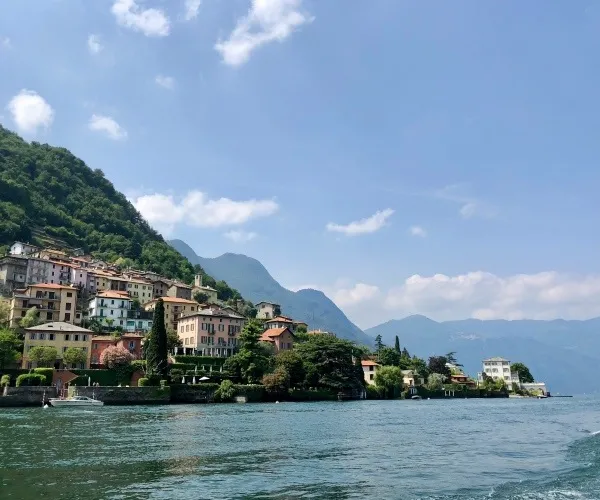
It was a surprise that one of our best lunches in the Lake Como area was not at a stone grotto-ed Michelin-starred restaurant or on a lakeside patio with the majestic Alps in the distance. It was a surprise that we didn’t need to get there by Vaporetto or pull up to a parking lot filled with purring Maseratis. It turns out, our pre-COVID trip to Italy was filled with surprises.
Glamorous Lake Como
Lake Como is distractingly beautiful, with much to offer from both visual and culinary perspectives. Soaring mountains plunge directly into the illustrious lake. Villages puddle neatly between valleys, and ceramic-tiled rooftops notch up the hills like bricks of red legos. Restaurants dot the perimeter of the lake, each offering breezy umbrella-ed decks from which to gaze.
Glacial Lake Como is awfully pleased with itself and has every right to be, nestled in this idyllic locale just an hour from Milan. It is no wonder it has been a retreat for aristocrats and the rich and famous since Roman times.
The lake itself offers a postcard image with each blink. Gorgeous boats (blink) alongside glitzy lakeside hamlets (blink) and swoon-worthy waterside cafes (blink). Glamorously dressed Italians, with their equally glamorous dogs in tow, teeter about (blink, blink, blink)—a snapshot of chic Italian life, all in one dreamy destination.
Daytrippin’
As glamorous as Lake Como may be, the explorer in me wondered what might lie just beyond the glam. Counterintuitively, we headed away from the lake, with nothing but our Lonely Planet guidebook and a tiny bumblebee of a car—cadmium yellow Fiat 500.
Buzzing up and around the steep hilltop villages of Lombardy offered us a chance to experience the less-touristy side of Lake Como. The rustic, the rambling, and the boutique-free side. Always chasing a view, we set off to see the fabled lakes from above. Our destination was Cima Sighignola, also known as the Balcony of Italy.
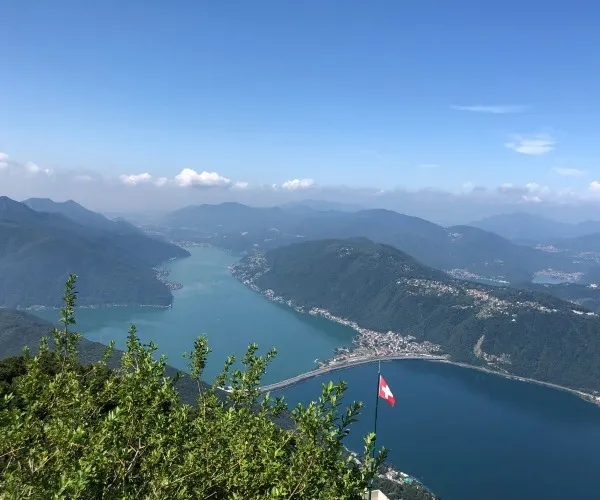
Not surprisingly, it was a challenge to get there. Roads became so narrow we were sure we were driving on sidewalks. Lanes looked so private; we confused them with driveways. Every turn had us doubting our navigation system, which often had our Fiat floating in the middle of a lake due to never-ending hairpin turns.
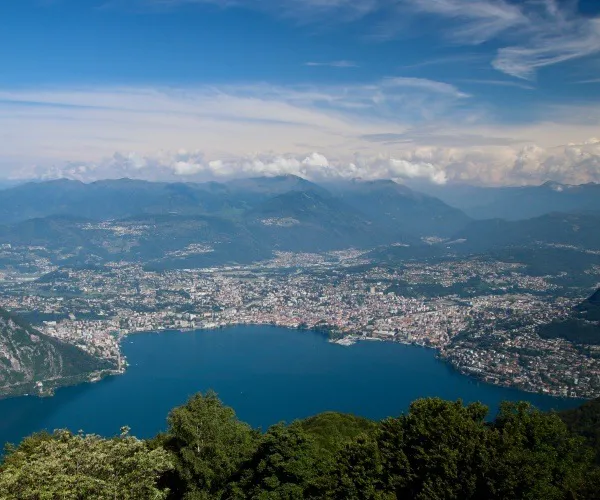
The Balcony of Italy
At 3120 meters above sea level, Cima Sighignola’s uninterrupted views of the lakes were worth the (gray) hair-raising turns. From our tourist-free aerie, we could see Lake Lugano, the city of Lugano, and the Swiss Alps, all at once.
We hovered there longer than we anticipated, mesmerized by the lakes’ panorama and the mountains peaks that kissed the clouds. An elderly Italian woman appeared from a small wooden shack, with a better than expected espresso. This shouldn’t have been a surprise. After all, this is Italy, a country whose self-worth is inherently coffee-based.
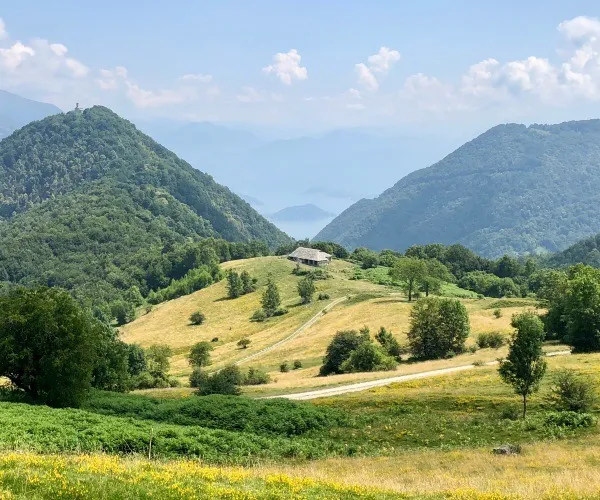
Population 7, 10, or 11?
Blindly following our Lonely Planet through another series of sharp switchbacks, we headed towards Erbonne, in the commune of San Fedele d’Intelvi. This pre-roman, 3000-year-old, pin-prick of a village was once a smuggler crossing between Italy and Switzerland. It was off-the-beaten-path, even by Lonely Planet standards.
We were on a mission to find Osteria del Valico, the sole restaurant of Erbonne, for the past 100 years. As of 2017, Wikipedia stated that the village of Erbonne had eleven inhabitants. Other sources claimed the population was anywhere from seven to ten. Regardless of the facts, this was a place worth finding.
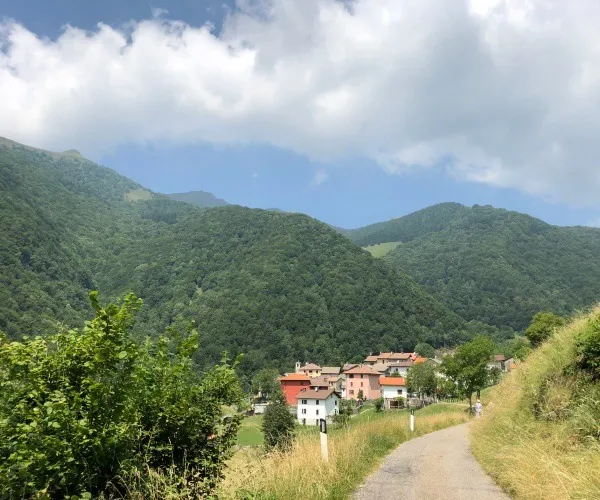
The best/only lunch in town
With 50 buildings (a combination of houses and stables), what Erbonne lacks in structure makes up for in ultra-rustic beauty. Erbonne, on the edge of the Swiss border, is surrounded by layers of overlapping mountains and a verdant, green patchwork of fields.
The village has no parking. I don’t mean ‘it was hard to find a parking space.’ I mean literally, there is no parking. Not to be deterred, we left the car outside of the village and walked. Wispy, yellow grasses lined our path and created a colorful backdrop to the simple pink, red, and white homes clumped in the near distance.
Climbing roses stuck firmly to painted walls. Patches of struggling wildflowers clung to dear life on crumbling edifices. Flowers poured out of semi-neglected window boxes. In Erbonne, time seemed to stand eerily still.
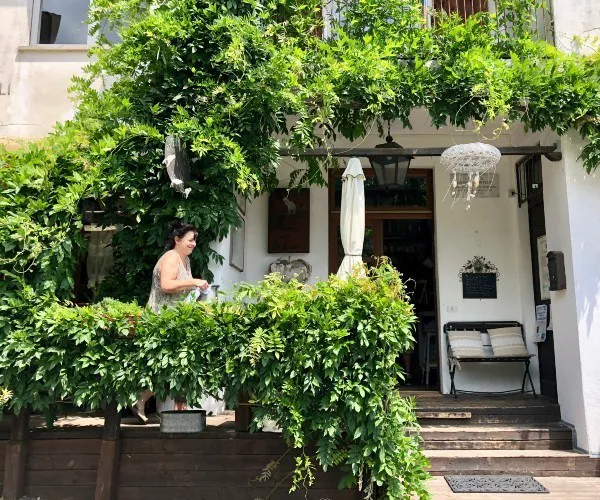
Carbo-loading
Osteria del Valico was easy to find. After all, it was the only restaurant in the village. Ancient, gnarly, wisteria vines had taken permanent ownership of the osteria’s once white facade. Wooden steps, warped by time, led to the humble tavern entrance.
We were guided through the original ‘shabby chic’ dining room towards the outdoor patio. The wide, planked floors had undoubtedly seen decades of foodies pass over them. Crooked black and white photo frames, filled with patrons from days long gone, adorned the walls. Lacy curtains, a collection of vintage ladles, and a chalkboard scrawled menu made the grandmother’s closet vibe that much more charming.
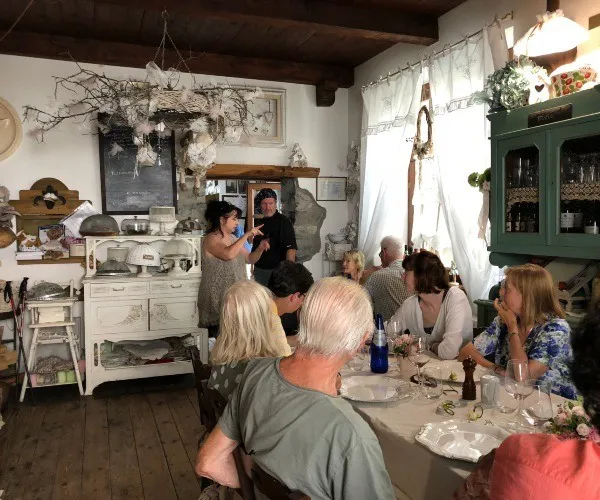
From the patio, we heard musical Italian laughter from a table within—the unmistakable sounds of friends with a long, comfortable history. I had noted the large group earlier. Every known villager might have been having lunch there that day! Church bells chimed the hour in the distance. We settled in.
The house special
Lonely Planet declared that Osteria del Valico’s house specialty was pizzoccheri. Never ones to argue with our travel bible, we promptly ordered. If it was good enough for the seven, ten, or eleven, locals of Erbonne, it was good enough for us. It turned out to be one of our best dishes of the trip. Surprise!
Pizzoccheri is a buckwheat pasta (80% buckwheat flour, 20% wheat flour), along the tagliatelle lines, usually cooked with greens and cubed potatoes (carbs on top of carbs). It is layered in various cheeses, like Valtellina Casera and ground Parmigiano Reggiano, before being dressed with garlic and fried lightly in butter.
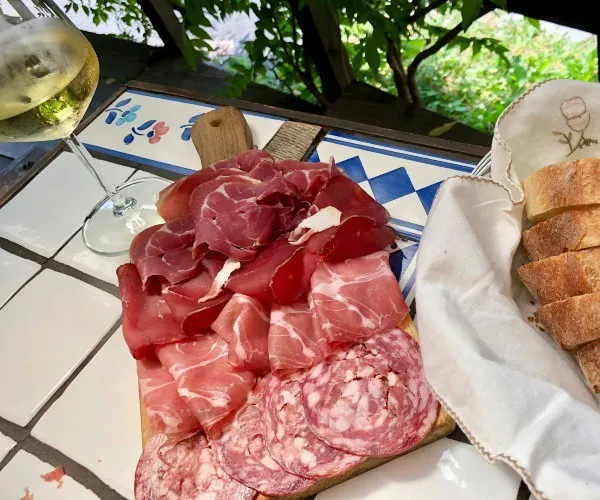
I swore I couldn’t eat it all, and I kept swearing—until I ate it all. How often do I get to have lightly fried pasta, I rationalized? Oh, and did I mention the charcuterie board piled high with Italian meats and rustic Italian bread we had already consumed? I made a mental note to cancel dinner.
A family affair
Osteria del Valico has changed locations over the years, and by 2002, had settled into a stone house on the edge of town. We met the chef/owner, his wife, and daughter, as well as a Swiss couple who had driven over for lunch from Geneva. Ahhhh, to live in Europe.
The chef, wearing a bad-ass skull patterned beret (that is, if a beret can ever be considered bad-ass), and his wife was engaging, warm, and friendly, despite the language barrier. To communicate, we attempted to find a common language. Eventually, French triumphed, as both my husband and the chef were fluent.
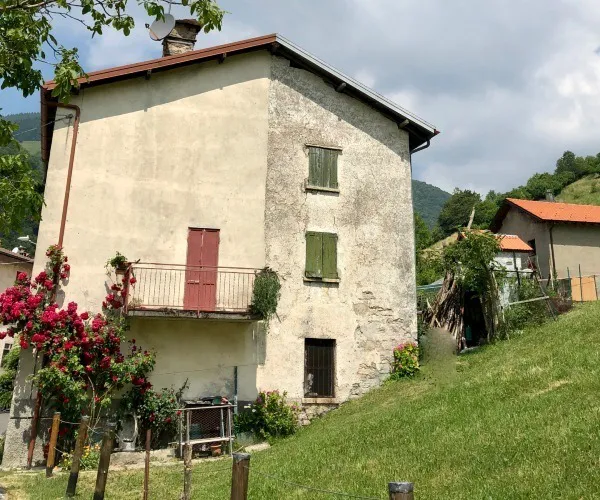
Found moments
Osteria del Valico has very little in the way of web presence. Aside from a few Trip Advisor comments, and a simple webpage, it is virtually off the Google grid. It is challenging to find a place like this, with simple fare and a convivial vibe, which I call a true ‘lost and found’ moment.
It’s likely true that not everyone will find this kind of day trip as exciting as we did. Not everyone gets a thrill from seeking out an alone restaurant, in a tiny village, with an unknown population, with the hope of uncovering the undiscovered. We are those people.
Exploring a combination of experiences when visiting a place with as much hype and hyperbole as Lake Como gave our trip more depth. I relished the juxtaposition of the obvious and the hidden. Both have a place in Lake Como and its bucolic surroundings. Why not have a bit of each? Chances are, you will be pleasantly surprised.
by Jamie Edwards
